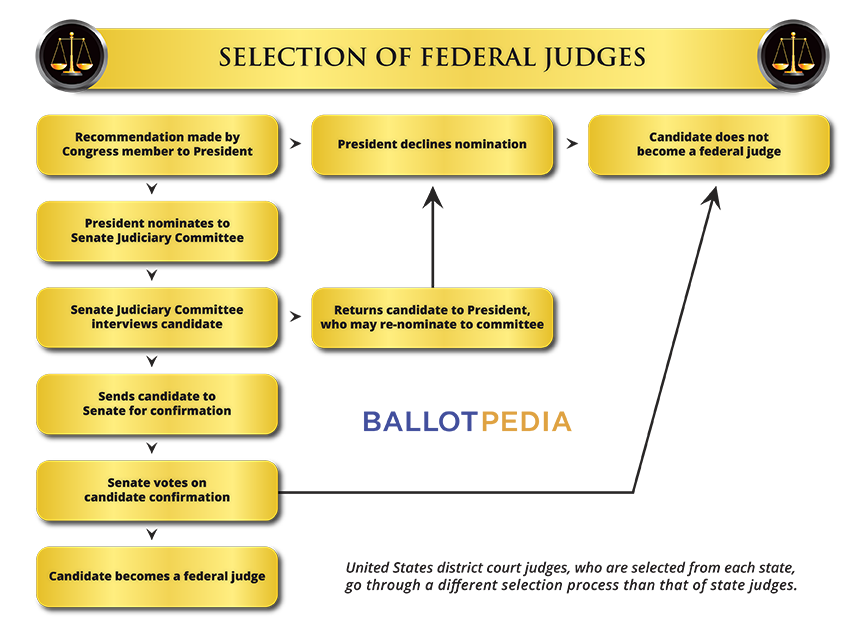Judicial selection in Vermont
| Judicial selection in Vermont | |
 | |
| Vermont Supreme Court | |
| Method: | Assisted appointment |
| Term: | 6 years |
| Vermont Superior Court | |
| Method: | Assisted appointment |
| Term: | 6 years |
| Vermont Probate Division | |
| Method: | Partisan election |
| Term: | 4 years |
Judicial selection refers to the process used to select judges for courts. At the state level, methods of judicial selection vary substantially in the United States, and in some cases between different court types within a state. There are six primary types of judicial selection: partisan and nonpartisan elections, the Michigan method, assisted appointment, gubernatorial appointment, and legislative elections. To read more about how these selection methods are used across the country, click here.
This article covers how state court judges are selected in Vermont, including:
As of April 2025, the selection of state court judges in Vermont occurred largely through the assisted appointment method.[1] Judges are appointed by the governor from a list of names provided by a nominating commission, after which they face confirmation from the Vermont Senate. Appointed judges face retention by a vote of the Vermont General Assembly at the end of each six-year term.[2]
Click here to notify us of changes to judicial selection methods in this state.
Vermont Supreme Court
- See also: Vermont Supreme Court
The five justices of the Vermont Supreme Court are selected through assisted appointment. The governor selects a nominee from a list of recommended candidates from a judicial nominating commission. The nominee must be confirmed by the Vermont Senate.[2] Once confirmed, appointees serve six-year terms. At the end of each term, judges face retention by a vote of the Vermont General Assembly.[2]
Qualifications
To serve on the Vermont Supreme Court, a judge must:
- be a state resident; and
- have practiced law as an attorney or served as a judge in the state for at least 10 years, with five years preceding their application to the commission.
Chief justice
The chief justice of the supreme court is chosen through the same assisted appointment method as the other judges on the court and serves in that capacity for a full six-year term.[2]
Vacancies
When the state Senate is in session, midterm vacancies are filled by the same assisted appointment method otherwise used to select judges. If the Senate is not in session, the governor may choose to make an interim appointment until the Senate convenes and acts upon the appointment. The appointed justice will serve until the Senate consents to the appointment. If the appointment is confirmed, the appointee will serve a six-year term. If the appointment is not confirmed by the Senate, the judicial office will be vacated.[3]
The map below highlights how vacancies are filled in state supreme courts across the country.
Vermont Superior Courts
- See also: Vermont Superior Courts
Judges on the superior court are selected through assisted appointment. The governor selects a nominee from a list of recommended candidates from a judicial nominating commission. The nominee must be confirmed by the Vermont Senate.[2] Once confirmed, appointees serve six-year terms. At the end of each term, judges face retention by a vote of the Vermont General Assembly.[2]
Qualifications
To serve on the Vermont Superior Courts, a judge must:
- be a state resident; and
- have practiced law as an attorney or served as a judge in the state for at least 10 years, with five years preceding their application to the commission.[2]
Chief judge
The chief judge of the superior court is appointed by the Vermont Supreme Court.[2]
Vacancies
When the state Senate is in session, midterm vacancies are filled by the same assisted appointment method otherwise used to select judges. If the Senate is not in session, the governor may choose to make an interim appointment until the Senate convenes and acts upon the appointment. The appointed justice will serve until the Senate consents to the appointment. If the appointment is confirmed, the appointee will serve a six-year term. If the appointment is not confirmed by the Senate, the judicial office will be vacated.[4][2]
Limited jurisdiction courts
Vermont has three types of limited jurisdiction court(s): Vermont Probate Division, Vermont Superior Courts, Environmental Division, and Vermont Judicial Bureau.
Vermont Probate Division
Judges serving in the probate division of the superior court are elected in partisan elections. They serve four-year terms.[5]
Vermont Superior Courts, Environmental Division
Judges of the Environmental Division are selected through assisted appointment where the governor appoints a judge from a nominating commission's list and the Vermont Senate confirms the appointee.[2] Once confirmed, appointees serve six-year terms. At the end of each term, judges face retention by a vote of the Vermont General Assembly.[2]
Judicial Bureau
Hearing officers of the Vermont Judicial Bureau are appointed by the chief superior court judge from among state bar members. They serve four-year terms.[2]
History
Below is a timeline noting changes to judicial selection methods in Vermont.
- 1974: The state constitution was amended, instating the following changes:
- The merit selection method was adopted for Vermont judges whereby a judicial nominating board submits a list of qualified candidates to the governor. The governor's appointee must then face confirmation by the state Senate.
- Established that judges were to serve six-year terms, after which they must be retained by a majority vote of the Vermont General Assembly.
- 1967: The General Assembly established a panel to review candidates for interim vacancies. The panel was to provide the governor with a list of qualified candidates from which to select a replacement judge.
- 1870: Established that all judges were to be elected by the General Assembly and serve two-year terms.
- 1850: Established that inferior court judges were to be elected by popular vote to one-year terms.
- 1786: Established that all judges were to be elected to one-year terms by a joint vote of the General Assembly and the council.
- 1777: Established that all judges were to be appointed by the governor with consent from the council.[6]
Courts in Vermont
In Vermont, there is one federal district court, a state supreme court, and trial courts of general and limited jurisdiction. These courts serve different purposes, which are outlined in the sections below.
Click a link for information about that court type.
The image below depicts the flow of cases through Vermont's state court system. Cases typically originate in the trial courts and can be appealed to courts higher up in the system.
Selection of federal judges
United States district court judges, who are selected from each state, go through a different selection process from that of state judges.
The district courts are served by Article III federal judges, who are appointed for life during good behavior. They are usually first recommended by senators (or members of the House, occasionally). The President of the United States nominates judges, who must then be confirmed by the United States Senate in accordance with Article III of the United States Constitution.[7]
In other states
Each state has a unique set of guidelines governing how they select judges at the state and local level. These methods of selection are:
Election
- Partisan election: Judges are elected by the people, and candidates are listed on the ballot alongside a label designating political party affiliation.
- Nonpartisan election: Judges are elected by the people, and candidates are listed on the ballot without a label designating party affiliation.
- Michigan method: State supreme court justices are selected through nonpartisan elections preceded by either partisan primaries or conventions.
- Retention election: A periodic process whereby voters are asked whether an incumbent judge should remain in office for another term. Judges are not selected for initial terms in office using this election method.
Assisted appointment
- Assisted appointment, also known as merit selection or the Missouri Plan: A nominating commission reviews the qualifications of judicial candidates and submits a list of names to the governor, who appoints a judge from the list.[8] At the state supreme court level, this method is further divided into the following three types:
- Bar-controlled commission: The state Bar Association is responsible for appointing a majority of the judicial nominating commission that sends the governor a list of nominees that they must choose from.
- Governor-controlled commission: The governor is responsible for appointing a majority of the judicial nominating commission that sends the governor a list of nominees they must choose from.
- Hybrid commission: The judicial nominating commission has no majority of members chosen by either the governor or the state bar association. These commissions determine membership in a variety of ways, but no institution or organization has a clear majority control.
Direct appointment
- Court appointment: Judges are selected by judges in the state judiciary.
- Gubernatorial appointment: Judges are appointed by the governor. In some cases, approval from the legislative body is required.
- Legislative election: Judges are selected by the state legislature.
- Municipal government selection: Judges are selected by the governing body of their municipality.
See also
External links
Footnotes
- ↑ Assisted appointment - where the governor selects a nominee from a list provided by a nominating commission.
- ↑ 2.00 2.01 2.02 2.03 2.04 2.05 2.06 2.07 2.08 2.09 2.10 2.11 American Judicature Society, "Methods of Judicial Selection: Vermont," accessed August 20, 2021 Cite error: Invalid
<ref>tag; name "general" defined multiple times with different content Cite error: Invalid<ref>tag; name "general" defined multiple times with different content - ↑ Vermont General Assembly, "Judiciary Department - § 33. Interim judicial appointments," accessed April 18, 2023
- ↑ Vermont General Assembly, "Judiciary Department - § 33. Interim judicial appointments," accessed April 18, 2023
- ↑ U.S. Constitution, "Vermont Constitution, Section 51," accessed September 18, 2014
- ↑ American Judicature Society, "History of Reform Efforts," accessed April 16, 2025
- ↑ U.S. Courts, "FAQ: Federal Judges," accessed March 26, 2015
- ↑ American Bar Association, "Judicial Selection: The Process of Choosing Judges," accessed August 10, 2021
Federal courts:
Second Circuit Court of Appeals • U.S. District Court: District of Vermont • U.S. Bankruptcy Court: District of Vermont
State courts:
Vermont Supreme Court • Vermont Superior Courts • Vermont Probate Court • Vermont Judicial Bureau
State resources:
Courts in Vermont • Vermont judicial elections • Judicial selection in Vermont






